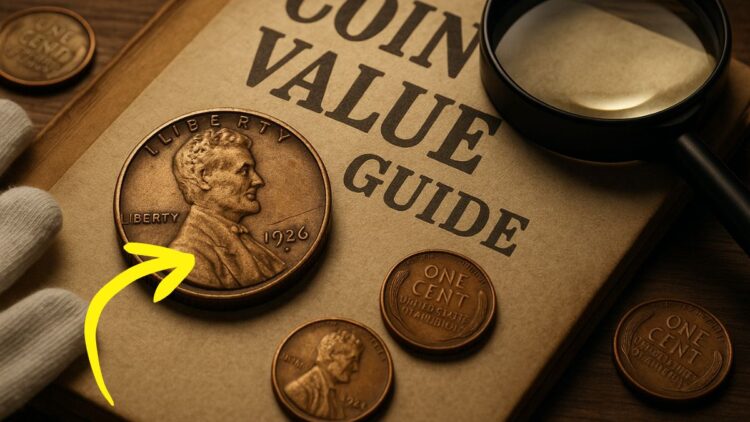The 1926 Wheat Penny is a significant coin in the world of numismatics. While it might seem ordinary at first glance, certain variations and errors make it highly sought after by collectors.
This guide delves into the details of the 1926 Wheat Penny, its value, and the rare errors that can significantly increase its worth.
Basic Information
- Mint Marks:
- Philadelphia (No Mint Mark): 157,088,000 minted
- Denver (D): 28,020,000 minted
- San Francisco (S): 4,550,000 minted
- Composition: 95% Copper, 5% Tin and Zinc
- Design:
- Obverse: Portrait of Abraham Lincoln
- Reverse: Two wheat stalks framing the words “ONE CENT”
Value by Mint Mark and Condition
| Mint Mark | Condition | Value Range (USD) |
|---|---|---|
| Philadelphia (No Mint Mark) | Good | $0.30 |
| Fine | $0.48 | |
| Extremely Fine | $0.60 | |
| Uncirculated | $2.44 | |
| Denver (D) | Good | $1.84 |
| Fine | $4.17 | |
| Extremely Fine | $9.16 | |
| Uncirculated | $18.00 | |
| San Francisco (S) | Good | $12.00 |
| Fine | $18.00 | |
| Extremely Fine | $55.00 | |
| Uncirculated | $90.00 |
Note: Values are approximate and can vary based on market demand and coin condition.
Rare Errors and Their Value
Certain minting errors can significantly increase the value of a 1926 Wheat Penny. Here’s a look at some notable errors:
1. Off-Center Strike
- Description: The coin is struck off-center, resulting in a portion of the design being missing.
- Value: Depending on the degree of the off-center strike and the coin’s condition, values can range from $75 to over $300.
2. Strike Through Error
- Description: Foreign material, such as debris, gets between the die and planchet, causing an impression on the coin’s surface.
- Value: Coins with noticeable strike-through errors can be worth between $50 and $200.
3. Capped Die Error
- Description: A die cap forms when metal from a struck coin sticks to the die, causing subsequent coins to have a distorted design.
- Value: Capped die errors are rare, and coins exhibiting this error can fetch values upwards of $300.
4. Repunched Mint Mark (RPM)
- Description: The mint mark is struck more than once, creating a doubled appearance.
- Value: Depending on the visibility and clarity of the repunching, these coins can be valued between $75 and $250.
Grading and Its Impact on Value
The condition of a coin, known as its grade, plays a crucial role in determining its value. Coins are graded on a scale from 1 to 70, with higher numbers indicating better condition. Here’s a brief overview:
- Good (G-4): Significant wear, but major details are visible.
- Fine (F-12): Moderate wear, with most details still clear.
- Extremely Fine (EF-40): Light wear, with all details sharp.
- Uncirculated (MS-60 to MS-70): No wear, with full original mint luster.
Coins with higher grades, especially those with rare errors, can command premium prices in the market.
Tips for Identifying Valuable 1926 Wheat Pennies
- Examine the Mint Mark: Check for the presence and clarity of the mint mark (D or S). A clear and well-struck mint mark can increase the coin’s value.
- Look for Errors: Use a magnifying glass to inspect for off-center strikes, strike-throughs, or repunched mint marks.
- Assess the Condition: Familiarize yourself with the grading scale to evaluate the coin’s condition accurately.
The 1926 Wheat Penny offers a fascinating glimpse into the world of coin collecting. While many may be common and of modest value, certain variations and errors can make them highly valuable. For collectors and enthusiasts, understanding these nuances can lead to rewarding finds and additions to their collections.
FAQs
How can I tell if my 1926 Wheat Penny has a minting error?
Carefully inspect the coin under good lighting using a magnifying glass. Look for signs of off-center strikes, foreign material impressions (strike-throughs), or doubled mint marks (RPMs).
Does the color of the coin affect its value?
Yes, the color can influence a coin’s grade. Coins with a rich red color (RD) are typically more valuable than those with brown (BN) or red-brown (RB) tones.
Where can I sell my valuable 1926 Wheat Penny?
Consider reputable coin dealers, online auction platforms like eBay, or specialized numismatic shows and conventions to sell your coin.

